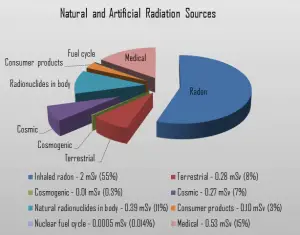The primary cosmic radiation consist of a mixture of high-energy protons (~87%), alpha particles (~11%), high-energy electrons (~1%) and a trace of heavier nuclei (~1%). The energy of these particles range between 108 eV and 1020 eV. A very small fraction are stable particles of antimatter, such as positrons or antiprotons. The precise nature of this remaining fraction is an area of active research.
 Subsequently, a large number of secondary particles, in particular, neutrons and charged pions are produced as a result of interactions between primary particles and the earth’s atmosphere. Cosmic rays interact with nuclei in the atmosphere, and produce also high-energy neutrons. According to UNSCEAR the fluency of neutrons is 0.0123 cm-2s–1 at sea level for a geomagnetic latitude of 45 N. Based on this, the effective annual dose from neutrons at sea level and at 50 degree latitude is estimated to be 0.08 mSv (8 mrem). Noteworthy, in the vicinity of larger heavier objects, e.g. buildings or ships, the neutron flux measures higher. This effect is known as “cosmic ray induced neutron signature”, or “ship effect” as it was first detected with ships at sea. Cosmic rays create showers in the atmosphere that include a broad spectrum of secondary neutrons, muons and protons. The secondary neutrons may be of a very high energy and may induce spallation events in materials at ground level. Therefore in the vicinity of larger heavier objects, these multiple neutrons produced in spallation events are referred to as “ship effect” neutrons.
Subsequently, a large number of secondary particles, in particular, neutrons and charged pions are produced as a result of interactions between primary particles and the earth’s atmosphere. Cosmic rays interact with nuclei in the atmosphere, and produce also high-energy neutrons. According to UNSCEAR the fluency of neutrons is 0.0123 cm-2s–1 at sea level for a geomagnetic latitude of 45 N. Based on this, the effective annual dose from neutrons at sea level and at 50 degree latitude is estimated to be 0.08 mSv (8 mrem). Noteworthy, in the vicinity of larger heavier objects, e.g. buildings or ships, the neutron flux measures higher. This effect is known as “cosmic ray induced neutron signature”, or “ship effect” as it was first detected with ships at sea. Cosmic rays create showers in the atmosphere that include a broad spectrum of secondary neutrons, muons and protons. The secondary neutrons may be of a very high energy and may induce spallation events in materials at ground level. Therefore in the vicinity of larger heavier objects, these multiple neutrons produced in spallation events are referred to as “ship effect” neutrons.
We hope, this article, Ship Effect – Cosmic Ray Induced Neutron Signature, helps you. If so, give us a like in the sidebar. Main purpose of this website is to help the public to learn some interesting and important information about radiation and dosimeters.